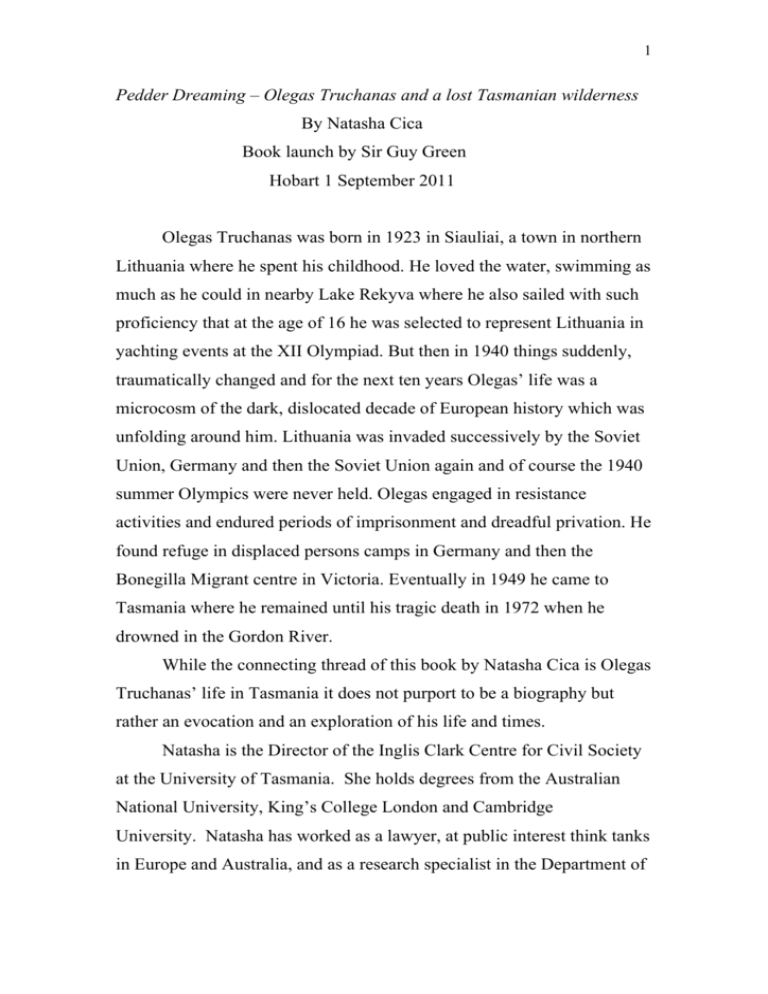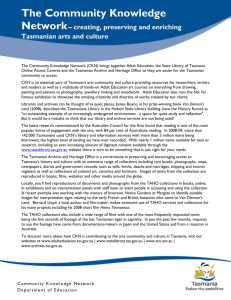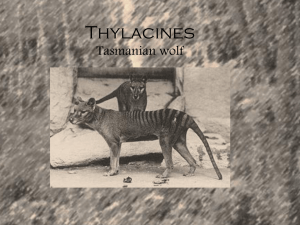Pedder Dreaming – Olegas Truchanas and a lost Tasmanian
advertisement

1 Pedder Dreaming – Olegas Truchanas and a lost Tasmanian wilderness By Natasha Cica Book launch by Sir Guy Green Hobart 1 September 2011 Olegas Truchanas was born in 1923 in Siauliai, a town in northern Lithuania where he spent his childhood. He loved the water, swimming as much as he could in nearby Lake Rekyva where he also sailed with such proficiency that at the age of 16 he was selected to represent Lithuania in yachting events at the XII Olympiad. But then in 1940 things suddenly, traumatically changed and for the next ten years Olegas’ life was a microcosm of the dark, dislocated decade of European history which was unfolding around him. Lithuania was invaded successively by the Soviet Union, Germany and then the Soviet Union again and of course the 1940 summer Olympics were never held. Olegas engaged in resistance activities and endured periods of imprisonment and dreadful privation. He found refuge in displaced persons camps in Germany and then the Bonegilla Migrant centre in Victoria. Eventually in 1949 he came to Tasmania where he remained until his tragic death in 1972 when he drowned in the Gordon River. While the connecting thread of this book by Natasha Cica is Olegas Truchanas’ life in Tasmania it does not purport to be a biography but rather an evocation and an exploration of his life and times. Natasha is the Director of the Inglis Clark Centre for Civil Society at the University of Tasmania. She holds degrees from the Australian National University, King’s College London and Cambridge University. Natasha has worked as a lawyer, at public interest think tanks in Europe and Australia, and as a research specialist in the Department of 2 the Parliamentary Library in Canberra. She has written on politics and culture in a wide range of publications. Natasha is especially well placed to write this book: as well as her academic attainments and broad experience she has a feel for the special nature of Tasmania which comes from the experience of growing up here tempered by the detachment which comes from living away from Tasmania for 20 years and then returning to see it through fresh eyes. Natasha crystallizes what impelled her to write the book in the opening passages: “Together and apart,” she writes “we Tasmanians have woven a dense web of myth around our heart shaped home of islands. Pull on any thread and quite a lot more than you’ve bargained for can unravel. So how could I even think of writing about Olegas Truchanas undoubtedly the stuff of Tasmanian legend? How could I not? Olegas Truchanas stands quietly among the 20th century’s most influential wilderness photographers, explorers, conservationists and democrats. … Today, the story of his life offers a departure point for reconsidering, or just plain considering, some basic questions about how we choose to live our lives.” In fact in Natasha’s hands that story turns out to be something much more than a mere point of departure: this fine work is in fact a portal into a gallery of cameos and panoramas both actual and metaphorical depicting Tasmania as a place and a society, a theatre for the telling of stories about the life and times of a remarkable man and a forum where a lively colloquium is taking place about a variety of themes ranging from the nature of Tasmanian culture and how we should debate 3 conservation issues to technical discussions about the proper place of Reckitts blue in the palette of Tasmanian landscape painters. Olegas Truchanas loved Tasmania with what his widow Melva describes as a “burning intensity”. He was especially attracted to Tasmania's wilderness areas, where he undertook solitary excursions, on foot and by canoe, and was the first person to travel all the way down the Serpentine and Gordon rivers from Lake Pedder to Macquarie Harbour in a kayak which he designed himself. Olegas made a photographic record of all his excursions initially in black and white and later in colour and won prizes in overseas and Australian competitions. He started publicly exhibiting his photographs in the 1950’s at lectures and slideshows which attracted large enthusiastic audiences all over the state. The impact which viewing photographs from Olegas’ slideshow had upon Natasha is almost palpable: she describes Olegas's work “as achingly, hauntingly beautiful. His slides slowly unfold and dissolve, washing in and out of each other like waves on the lake, a rhapsody of soft colour so much better hanging in light than printed on a page. There is the lake in morning mists, silver sands and pale quartz beach in daylight, silhouettes of eucalypts, Mount Anne standing like a sentinel on the horizon, a sunset peering through a lowering sky above the darkened waters, the moon on the tannin-leached lake, Buckle's Bonnet in the eerie green light of dawn, and more and more.” Initially Olegas’ motivation in showing his pictures was simply to bring home to Tasmanians how spectacularly beautiful this part of the island was, but when plans for the flooding of Lake Pedder were made public, his purpose became more focussed and urgent. “Is there any reason why, given enlightened leadership, the idea of beauty could not become an accepted goal of national policy?” He asks. “Is 4 there any reason why Tasmania should not be more beautiful on the day we leave it, than on the day we came? If we can revise some of our attitudes towards the land under our feet - if we can accept the role of a steward, and depart from the role of the conqueror; if we can accept the view that man and nature are inseparable parts of the unified whole - then a Tasmania that is truly beautiful can be a shining beacon in a dull, uniform and largely artificial world”. While Natasha writes as someone who is in sympathy with those who campaigned against the flooding of Lake Pedder this is not a polemical work or a simplistic morality tale about virtuous conservationists versus uncaring industries: it is a nuanced account which recognises, in Natasha’s words, the complexity of the human truth behind the debate. We learn, for example, that while Olegas campaigned against the flooding of Lake Pedder by the Hydro Electric Commission, his job as an employee of the Hydro was never in jeopardy; and we learn too that the Hydro Commissioner Sir Allan Knight not only attended an exhibition of Lake Pedder paintings and photographs held to raise funds for the save Lake Pedder campaign, but sought out Olegas’ advice as to which painting he should buy. Natasha’s account of her own reaction to today’s Lake Pedder is testament to the integrity of this book. Natasha described the new Lake Pedder as “an awe inspiring, heavenly place, the sky and air and water all shades of ozone like a max Angus watercolour that someone has pulled into astonishingly sharp focus.” Even so she concludes that while “today’s lake is beautiful. Yesterday’s was exquisite.” But the point is that her lyrical description of today’s lake shows that she is able to rise above the almost religious view held by some that to say anything positive about the modern lake is some form of heresy or at least betrayal. 5 The story of Olegas’s life in Tasmania in this book carries in its train a larger exploration of Tasmanian culture. Through Elspeth Vaughan Olegas was introduced to a group of artists who met on Sundays to paint and talk and encourage and sometimes criticise each other. Early members of the group included Roy Cox, Max Angus, Patricia Giles, Harry Buckie, Elspeth Vaughan and a number who joined the group later or occasionally joined them like John Eldershaw and Lloyd Rees. The way in which they influenced, respected and enriched each other is epitomized by the well known exchange between Olegas and Max Angus from which the title of this book is taken, when Olegas said to Max “paint me a dream of Pedder- anyone can take a photograph- I want a dream of Pedder”. Natasha sees the Sunday group as part of a tradition which goes back to the days of Sir John and Lady Franklin in the 1830’s. During their six years in the colony they created what Natasha felicitously describes as a kind of Southern Salon in the European Enlightenment tradition when they actively and personally promoted education, the arts, science, exploration and intellectual life generally in Tasmania. And Natasha is right to recognise them: we are all the beneficiaries of what flowed from Sir John and Lady Franklin’s initiatives: a culture which values education and artistic and intellectual endeavour, the Royal Tasmanian Botanical Gardens, the Tasmanian Museum and Art Gallery, the Royal Society, not to mention that delightful Greek Doric temple in Lenah Valley, Ancanthe, which is now the home of the Hobart Art Society, are all part of their legacy which endures to this day. Natasha’s fact based treatment of the Franklins stands in refreshing contrast to the caricatures of them which seem to be currently fashionable in some literary circles. The Sunday group and the group which formed around Olegas Truchanas can be seen as very much a part of that Southern salon 6 tradition. They can trace their cultural lineage back through groups such as the Minerva club and other groups formed in the 1880’s around Andrew Inglis Clark, which were interested in discussing and advancing the arts, philosophy, literature and poetry. Appropriately, Andrew Inglis Clark is the same man after whom the Centre for Civil Society of which Natasha is the director was named. And even more directly the Sunday group can trace its ancestry to the 19th century Tasmanian landscape painters Natasha discusses in the book including the first artist to sketch Lake Pedder, William Charles Piguenit. Perhaps what emerges from this book is the realization that in one form or another Tasmania has always been a Salon. The relationship between people and place – what Natasha at one point calls psycho-geography is a pervasive theme of the book. The paintings of the Sunday group are a manifestation of their visual perception of and emotional reaction to the Tasmanian landscape; and fortunately for us those paintings also turn out to be extraordinarily attractive works of art which we can all enjoy. The significance of the relationship between people and place is also at the heart of the affinity between the members of the Sunday group and Olegas, it being, in the words of Max Angus, derived from their shared “common interest in natural things, and the sharing of this through the agency of the camera was the core of it all” While photographer Lucia Rossi deplores what she characterises as the voyeuristic forms of wilderness photography, when you look at Olegas’ images she observes, “you get a real sense of the maker’s connection with the place.” And Olegas himself quite explicitly talked about his feeling that he could communicate “both ways” with the wild south west of Tasmania. 7 Natasha is aware that not everyone will be comfortable with some of the questions about the characteristics of Tasmanian society which she raises from time to time in the book. But her treatment of these questions is thoughtful and circumspect. “(I)t can be dangerous” she warns “to talk in types - they slide fast into stereotypes.” And the book itself effectively refutes some of the generalisations that are sometimes made about Tasmania. After citing instances suggesting that Tasmanians reacted warily to the foreignness of the post war migrants who settled here, Natasha cites the counter example of Olegas himself who found a space in Tasmania that generously accommodated and genuinely appreciated him. Similarly, suggestions that somehow Tasmanian society is narrow or stifling - “is Tasmania a salon or a prison?” Natasha asks – are arguably rebutted by the thrust of the whole book: prisons are not fertile ground for the flowering of the arts and artistic creativity which Natasha describes and celebrates in this book. And she records Max Angus’ view that living in Hobart is liberating for artists. He has, he says “drawn sustenance from both the past and present without being a slave to either.” And, in a characteristic assertion of individuality he counsels, “When everyone else is planting strawberries, plant cabbages.” Five years in the writing, this is a scholarly, thoroughly researched book which draws upon interviews with scores of people, many written sources and Natasha’s own experiences and perceptive eye. The work is superbly illustrated by reproductions of paintings from the Sunday group mainly sourced from private collections and by Olegas Truchanas photographs including previously unpublished images from the slideshows through which he transported his audiences to Lake Pedder and the South West wilderness. 8 In this work Natasha Cica has wonderfully realized her aim of creating a special Tasmanian cultural artefact. And, as will be obvious from the passages I have cited, she has achieved this through the medium of beautiful, poetic prose which is both a joy to read and perfectly attuned to the people, places, stories and themes which are the subject of this book. The last paragraphs of the book epitomize its flavor and character: “… simply walk, slowly, on the long empty beach. … Watch the water, calm now. A line of seagulls sits on its skin, soaking up the last of the cool sun, eyeing off pretty silver fish that you can't see. Stay with the water, and fold in the sky. Count the infinite, impossible blues. Name them all. Take your time. The wind's picking up, sharp as a frozen whip. Wrap up and watch the sun ease itself down behind the cold dunes. The sky flashes to life in splotches of hot salmon. Then it's all suddenly darker, deepest blue, twilight, gone. Another watercolour Sunday in Tasmania.” It is with great pleasure that I launch Pedder Dreaming – Olegas Truchanas and a lost Tasmanian wilderness. 9







